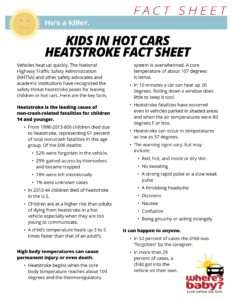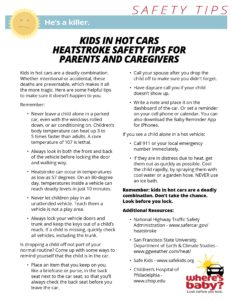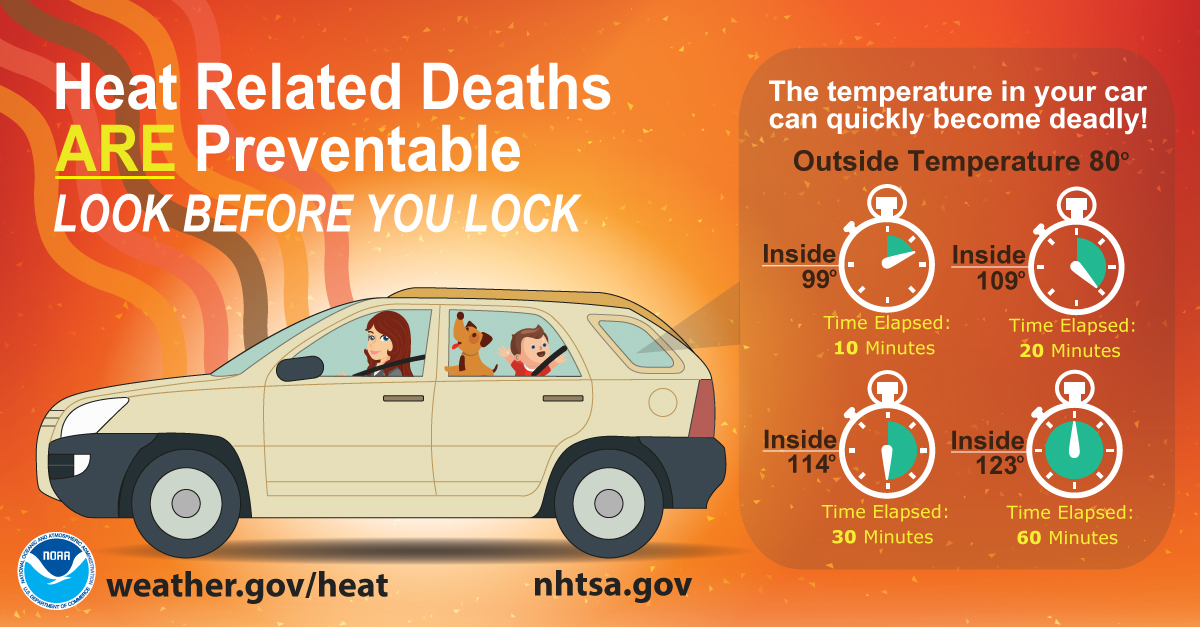Never leave children unattended in vehicles, especially during hot weather.
Kids play in cars or wander outside and get into a car and can die in 10 minutes! A reported 51 young children died in hot cars in 2019, according to weather.gov/heat! Cars can heat up quickly when left in the sun. Get resources to remind you or friends with children in both English and Spanish from the National Highway Traffic Safety Administration.

Several measures are recommended to prevent these types of deaths from occurring. They include:
- Create reminders. More than half of child heat stroke deaths occur because parents and caregivers become distracted and exit their vehicle without their child. To help prevent these tragedies parents can:
- Place a cell phone, purse, briefcase, gym bag or something that is needed at your next stop on the floor in front of a child in a backseat. This will help you see your child when you open the rear door and reach for your belongings.
- Set the alarm on your cell phone as a reminder to you to drop your child off at day care.

- Set your computer calendar program to ask, “Did you drop off at day care today?”
- Establish a plan with your day care that if your child fails to arrive within an agreed upon time, you will be called. Be especially mindful of your child if you change your routine for day care.
- Don’t underestimate the risk. The inside of vehicles can quickly heat up, even on relatively cool days, so you should never leave your child alone in a car. Don’t underestimate the risks and leave them even “just for a minute.”
- Lock cars and trucks. Thirty percent of the recorded heat stroke deaths in the U.S. occur because a child was playing in an unattended vehicle. These deaths can be prevented by simply locking the vehicle doors to help assure that kids don’t enter the vehicles and become trapped.
- Immediately dial 911 if you see an unattended child in a car. EMS professionals are trained to determine if a child is in trouble. The body temperature of children rises three to five times faster than adults. As a result, children are much more vulnerable to heat stroke. Check vehicles and trunks first if a child is missing.
Additional tips are recommended to avoid other heat-related injury and illness:
- Drink plenty of fluids. Increase your normal fluid intake regardless of your activity level. You will need to drink more fluids than your thirst level indicates. This is especially true for people age 65 or older who often have a decreased ability to respond to external temperature changes. In addition, avoid drinking beverages containing alcohol, because they will actually cause you to lose more fluid.
- Wear appropriate clothing and sunscreen. Choose lightweight, light colored, loose fitting clothing. In the hot sun, wear a wide-brimmed hat that will provide shade and keep the head cool. Sunscreen should be SPF 15 or greater and applied 30 minutes before going out into the sun.
- Stay cool indoors. The most efficient way to beat the heat is to stay in an air-conditioned area. If you do not have an air conditioner, consider visiting a mall or public library.
- Schedule outdoor activities carefully. If you must be out in the heat, try to plan your activities so that you are outdoors either before noon or in the evening. Rest periodically so your body’s thermostat will have a chance to recover.
- Use a buddy system. When working in the heat, monitor the condition of your co-workers and have someone do the same for you. Heat-induced illness can cause a person to become confused or lose consciousness.
- Monitor those at high risk. Those at greatest risk of heat-related illness include:
- Infants and children up to 4 years of age
- People 65 years of age or older
- People who are overweight
- People who overexert during work or exercise
- People who are ill or on certain medications for blood pressure or diuretics.

